| CPC B60W 30/045 (2013.01) [B60W 30/18172 (2013.01); B60W 2520/26 (2013.01); B60W 2720/26 (2013.01); B60W 2720/30 (2013.01)] | 7 Claims |

|
1. A longitudinal and lateral vehicle motion cooperative control method based on a fast solving algorithm, comprising the following steps:
calculating a desired yaw rate according to a steering wheel rotation angle and a current vehicle traveling speed;
constructing a nonlinear optimization problem according to the desired yaw rate and a current actual motion state of a vehicle, wherein an objective function of the nonlinear optimization problem is configured for tracking the desired yaw rate, and simultaneously for restraining a lateral speed and a tire slip ratio of the vehicle;
solving the nonlinear optimization problem to calculate desired slip ratios of four tires;
calculating an additional torque of each tire according to an actual slip ratio and the desired slip ratio of the tire; and
sending the additional torque of each tire to an actuator of the vehicle for a cooperative control; wherein
solving the nonlinear optimization problem based on Pontryagin's minimum principle including the following processes:
introducing a relaxation factor to convert a state constraint of a system;
defining a Hamiltonian function H within a prediction horizon, independent variables of the Hamiltonian function being the desired slip ratios of the four tires;
discretizing a canonical equation of the nonlinear optimization problem to obtain necessary conditions meeting an optimal control, and acquiring terminal conditions of the nonlinear optimization problem according to Pontryagin's minimum principle;
performing Taylor expansion on an original Hamiltonian function, and converting the Hamiltonian function H into a multivariate quadratic function
assuming ∂H/∂u=0, and solving the multivariate quadratic function to obtain a stationary point Ps of the Hamiltonian function; and
the stationary point Ps being a minimum point of the Hamiltonian function H, acquiring an optimal explicit control input at each moment, namely the desired slip ratio of each tire.
|